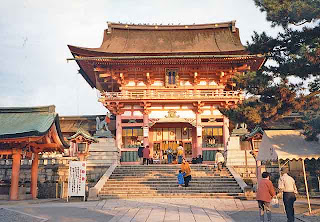
One of Kyoto's oldest (founded in 711 AD) and most revered Shinto shrines, Fushimi Inari serves as the headquarters for all the 40,000 shrines dedicated to Inari across Japan.
Originally the god of rice, Inari now governs the modern equivalent: success and prosperity in business. Fushimi Inari Shrine draws thousands of businessmen and tradespeople seeking blessings for their enterprises, especially at the first prayers of the New Year.





Fushimi Inari is noted for its remarkable sight of some 10,000 small torii (shrine gates) that arch over a long path up the hill behind the shrine. It takes about two hours to walk along the whole trail, and there are nice views of Kyoto from the top. Donated and inscribed by businesses and individuals thankful for their prosperity, the long tunnel of torii is one of the most iconic visions of Kyoto.






Along the hiking trail, small restaurants serve Kitsune Udon ("Fox Udon"), a noodle soup topped with pieces of aburaage (fried tofu), a treat favored by foxes. You can also try Inari sushi, which is fried tofu wrapped around sweetened rice (One of my favorite things to eat!).
At the bottom of the hill are the rōmon (楼門, "main gate") and the Go-Honden (御本殿, "main shrine"). Behind them in the middle of the mountain, the Oku miya (奥宮, "inner shrine") is reachable by a path lined with thousands of torii. To the top of the mountain are tens of thousands of tsuka (塚, "mound") for private worship.


Kitsune holding a key in its mouth, at the main gate of the Fushimi Inari shrine.


If possible, visit Furshimi Inari near dusk — you'll be much more likely to wander alone through the tunnels of torii in the quiet woods, which is a magical experience as daylight fades. Foxes are said to be the messengers of Inari, and stern bronze foxes (kitsune) can be seen throughout the shrine. Inari's foxes are generally considered helpful, but they have also been said to bewitch people.
No comments:
Post a Comment